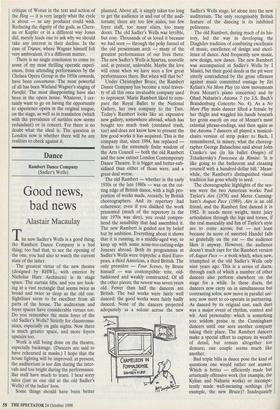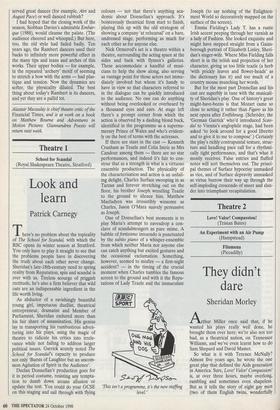Dance
Good news, bad news
Alastair Macaulay
The new Sadler's Wells is a good thing; the Rambert Dance Company is a bad thing; too bad that, to see the opening of the one, you had also to watch the current state of the latter.
The greatest virtue of the new theatre (designed by RHWL, with exterior by Nicholas Hare Architects) is its stage space. The curtain lifts, and you are look- ing at a vast rectangle that seems twice as broad and twice as deep as the old one. Sightlines seem to be excellent from all parts of the house. The auditorium and foyer spaces have considerable virtues too. Do you remember the main foyer of the old Sadler's Wells? Strictly for claustroma- niacs, especially on gala nights. Now there is much greater space, and more foyers upstairs too.
Work is still being done on the theatre, especially backstage. (Dancers are said to have rehearsed in masks.) I hope that the house lighting will be improved: at present, the auditorium is too dim during the inter- vals and too bright during the performance. Bar staff have much to learn. I hear sorry tales (just as one did at the old Sadler's Wells) of the ladies' loos.
Some things should have been better planned. Above all, it simply takes too long to get the audience in and out of the audi- torium; there are too few aisles, too few foyer staff, too many stairs, too many doors. The old Sadler's Wells was terrible, but cosy. Thousands of us loved it because we had seen — through the poky funnel of the old proscenium arch — many of the greatest performances of our lives there. The new Sadler's Wells is Spartan, nouvelle and, at present, unlovable. Maybe the love will come when we have seen a few great performances there. But when will that be?
Under Christopher Bruce, the Rambert Dance Company has become a total traves- ty of all this once invaluable company used to represent. Marie Rambert liked to com- pare the Royal Ballet to the National Gallery, her own company to the Tate. Today's Rambert looks like an expensive new gallery, somewhere abroad, which has bought too much trash (outdated trash, too) and does not know how to present the few good works it has acquired. This is the company that, since 1994, has replaced — thanks to the extremely finite wisdom of the Arts Council — both the old Rambert and the now extinct London Contemporary Dance Theatre. It is bigger and better-sub- sidised than either of those were, and a great deal worse.
The old Rambert — whether in the early 1930s or the late 1980s — was on the cut- ting edge of British dance, with a high pro- portion of works made, recently, by British choreographers. And its repertory had coherence; even if you disliked the work presented (much of the repertory in the late 1970s was dire), you could compre- hend the sensibility that had assembled it. The new Rambert is guided not by belief but by ambition. Everything about it shows that it is running, in a middle-aged way, to keep up with some none-too-cutting-edge Joneses abroad. Both its programmes at Sadler's Wells were triptychs: a third Euro- pean, a third American, a third British. The only premiere — Four Scenes, by Bruce himself — was contemptible: trite, old- fashioned and weakly constructed. Of all the other pieces, the newest was seven years old. Fewer than half the dancers are British. The bad works were fairly well danced; the good works were fairly badly danced. None of the dancers projected adequately as a soloist across the new Sadler's Wells stage, let alone into the new auditorium. The only recognisably British feature of the dancing is its inhibited politeness.
The old Rambert, during much of its his- tory, led the way in developing the Diaghilev tradition of combining excellence of music, excellence of design and excel- lence of dance. And frequently new music, new design, new dance. The new Rambert was accompanied at Sadler's Wells by I Musici, but their good deeds in the pit were utterly contradicted by the gross offences against music committed onstage by Jiri Kylian's No More Play (to slow movements from Mozart's piano concertos) and by Ohad Naharin's Axioma 7 (to J.S. Bach's Brandenburg Concerto No. 4). As a No More Play male dancer lifted a female by her thighs and waggled his hands beneath her groin exactly on one of Mozart's most celestial phrase-endings, and then again as the Axioma 7 dancers all played a musical- chairs version of strip poker to Bach, I remembered, in misery, what the choreog- rapher George Balanchine said about John Cranko's use (in his ballet Onegin) of Tchaikovslcy's Francesca da Rimini: 'It is like going to the bathroom and cleaning yourself with a hundred-dollar bill.' Mean- while, the Rambert's distinguished visual tradition has gone wholly to seed.
The choreographic highlights of the sea- son were the two American works: Paul Taylor's Airs (1978) and Merce Cunning- ham's August Pace (1989). Airs is an old friend, and the Rambert first danced it in 1982. It needs more weight, more juicy articulation through the legs and torsos, if the real musicality and fun of Taylor's style are to come across; but — not least because its score of assorted Handel falls so gratefully on the ear — the audience likes it anyway. However, the audience doesn't much care for the Rambert version of August Pace — a work which, when new, triumphed at the old Sadler's Wells only nine years ago. This is a series of duets, through each of which a number of other dancers also perform elsewhere on the stage for a while. In these duets, the dancers now carry on in simultaneous but contrasting solos; now move in parallel uni- son; now meet to co-operate in partnering. As danced by its original cast, each duet was a major event of rhythm, control and wit. And personality: which is something you seldom praise in the Cunningham dancers until one sees another company taking their place. The Rambert dancers make a special effort to capture its wealth of detail, but remain altogether too demure; one couple seems much like another.
Bad triple bills in dance pose the kind of questions one would rather not answer. Which is better — efficiently made but artistically offensive work (for example, the Kylian and Naharin works) or incompe- tently made well-meaning nothings (for example, the new Bruce)? Inadequately served great dances (for example, Airs and August Pace) or well danced rubbish?
I had hoped that the closing work of the season, Siobhan Davies's admirable Embar- que (1988), would cleanse the palate. (The audience cheered and whooped.) But here, too, the old style had faded badly. Ten years ago, the Rambert dancers used their backs to infinitely more powerful effect in the many tips and leans and arches of this works. Their upper bodies — for example, in the repeated 'archery' motif of seeming to stretch a bow with the arms — had plas- tique and tension. Now the dynamics are softer, the physicality diluted. The best thing about today's Rambert is its dancers, and yet they are a pallid lot.
Alastair Macaulay is chief theatre critic of the Financial Times, and is at work on a book on Matthew Bourne and Adventures in Motion Pictures. Giannandrea Poesio will return next week.



















































































 Previous page
Previous page